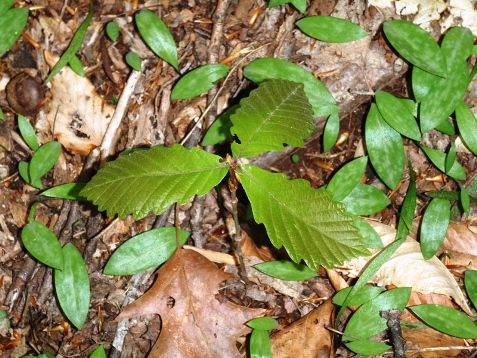|

Contact: Kate Jensen , (610) 783-1035 VALLEY FORGE, PA - The forest at Valley Forge National Historical Park is continuing to recover from decades of over-browsing by white-tailed deer. Following four years of implementation of the park's White-tailed Deer Management Plan/Environmental Impact Statement, monitoring by National Park Service staff has documented native species seedlings that had not been just a few years ago, including maple, red bud, maple-leaf viburnum, dogwood, oak, tulip-poplar, black gum, hickory, cherry, hackberry, ash, and sassafras. Preliminary data indicate an increase in the number of seedlings of 850% in the first four years of the implementation of the plan. Kate Jensen, the park's Ecologist, noted, "Park staff and visitors continue to report native trees, shrubs and wildflowers parkwide. It's exciting to see the forest recover."These sightings indicate that the deer management plan is beginning to achieve its objective of allowing the native forest to grow and mature in order to provide habitat for a range of native wildlife species. The increasing deer population over the last two decades and the pressure of over-browsing had eliminated regeneration. No seedlings outside fenced areas had been left uneaten. The absence of vegetation had led to elimination of habitat, soil erosion, and the spread of exotic invasive species.
In March, the park completed the fourth year of plan implementation. Park staff worked with the United States Department of Agriculture, Animal and Plant Health Inspection Service, Wildlife Services on eight nights between November 2013 and March 2014 to remove 116 deer from the park through sharpshooting. A total of 3,403 pounds (over one ton) of meat resulting from this action were donated to the Central Pennsylvania Food Bank and provided to food pantries, soup kitchens, and other organizations across 21 counties in Pennsylvania.
The deer management action included extensive measures to ensure a safe, humane, and successful operation, such as using highly qualified and experienced marksmen familiar with the park's geography and with conducting reduction activities in a suburban environment, conducting population reduction actions only when the park is closed, observing safety zones, and using special, non-lead ammunition that is safe for use in the environment. The NPS closely coordinated all activities with township and state law enforcement officials and with the Pennsylvania Game Commission.
The estimated deer density in the park will be 49 deer per square mile (260 deer) after fawns are born this spring. Although still above the plan's initial target level of 31-35 deer per square mile, this represents a significant reduction from the estimated 241 deer per square mile (1,277 deer) present in 2009.
The number of deer removed in future years will be based on the results of annual spring deer population monitoring, updated calculations of deer reproductive rates, and forest health monitoring. This summer, park staff again will count trees within long-term monitoring plots to assess progress toward the forest regeneration goal of 8,079 tree seedlings per acre.
The park will continue to use lethal reduction until the initial target deer density is achieved or forest regeneration reaches its target. Once the target deer density or adequate forest regeneration is achieved, and once an acceptable reproductive control agent becomes available, the park will use reproductive control to maintain the target deer density level.
|
Last updated: February 26, 2015
